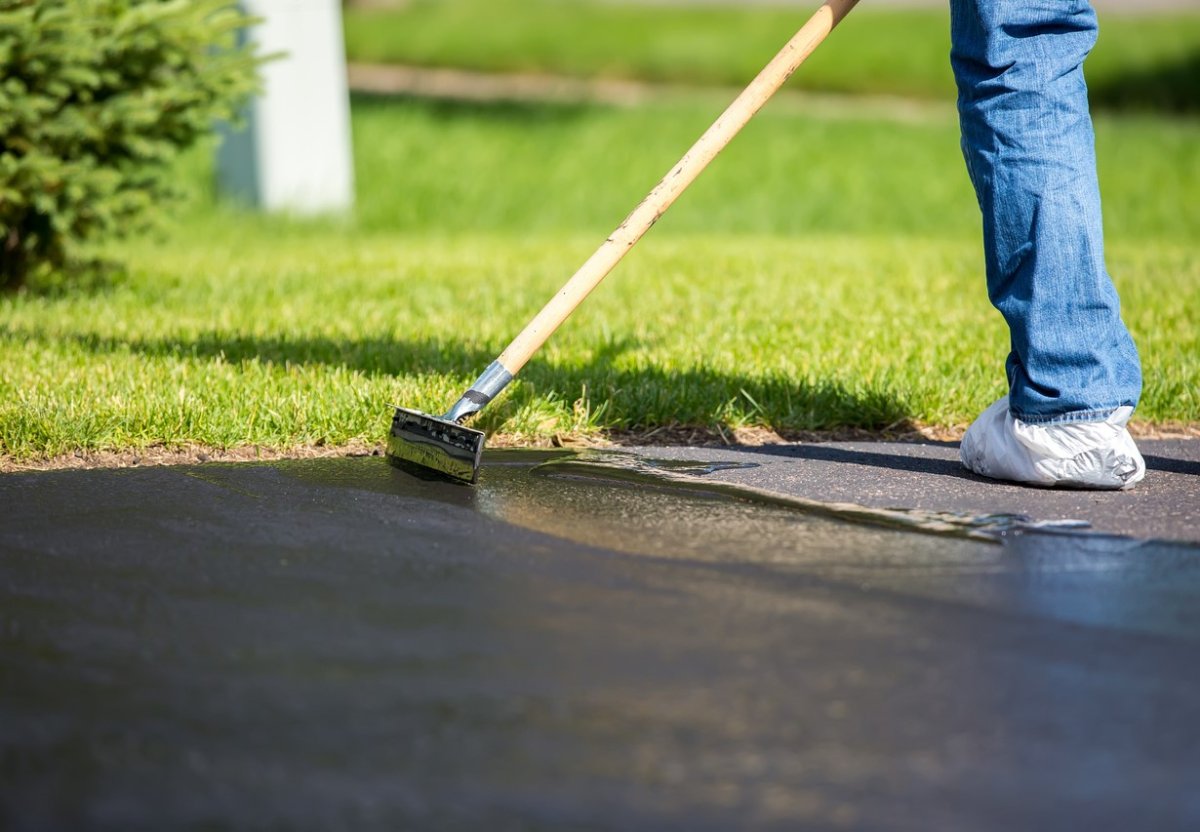We may earn revenue from the products available on this page and participate in affiliate programs. Learn More ›
Your driveway is the first thing passersby and visitors see, and it’s a vital element in your home’s curb appeal. If your driveway is pitted, stained, cracked, or otherwise deteriorating, you’re probably anxious to make repairs and get it back in shape. The three main types of driveways—asphalt, concrete, and gravel—all have their own characteristics, and each requires different types of repair. Read on to discover the pros and cons of each type and the tips you need for repairing each driveway’s respective problems.

When Repairing a Driveway Made of Asphalt…
A well-maintained asphalt driveway, sometimes called blacktop due to its muted black surface, runs $2.50 to $4 per square foot for installation and can last up to 20 years. Heavy traffic, dirt build-up, and the use of chemical ice-melt products, though, can shorten its useful life, resulting in small cracks that can increase in size to full-blown potholes if they not repaired promptly.
- Installing an asphalt driveway isn’t a DIY project—it requires the use of large commercial machines that heat the hot asphalt mixture and heavy rollers that smooth it in place—but a homeowner can often handle the repair.
- To repair one or two small cracks, all you need is a tube of asphalt sealant, such as Red Devil Driveway Repair (available from Amazon). You dispense it via a standard caulking gun directly into the crack to fill, seal, and stop the deterioration process.
- If your driveway contains many cracks, asphalt repair tubing, such as Crack-Stix (available from The Home Depot), may be the better choice. The pliable tubing is inserted into the cracks and then heated with a torch to melt the tar, filling and sealing the crack.
- Numerous tiny spider web cracks in asphalt can be remedied with a mop-on asphalt sealer, such as Henry Driveway Filler and Sealer (available from Walmart). This product contains an asphalt resin that can be applied without heat. To keep an asphalt driveway in great shape, it’s a good idea to apply this type of filler and sealer every three to five years.
- Once a crack forms, if it’s not promptly sealed, water seeps in and over time, it can destabilize the gravel fill beneath the asphalt, causing the asphalt to crumble away and create a pothole. Fortunately, you can still repair this problem yourself with an asphalt patching product, such as Asphalt Patch and Pothole Filler (available from Amazon). This type of product is packed into the pothole to fill it and match the existing driveway.
RELATED: What’s the Difference? Concrete vs. Asphalt Driveways

When Repairing a Driveway Made of Concrete…
Concrete is the most common type of driveway because small crews and even enthusiastic homeowners with concrete-pouring experience can install it and repair it. Running approximately $4 to $5 per square foot for professional installation, concrete is one of the strongest construction materials around, and it forms a solid, durable surface that can give you as much as 50 years of service.
The quality of concrete can vary from one driveway to the next, based on factors such as how well it was cured after being poured, how much water was in the concrete mix (excess water can weaken the material), and whether the area contains clay soil, which tends to move slightly and crack concrete slabs. Unsightly grease and oil stains are also a problem with concrete driveways. Here’s how to tackle the repairs.
- If your concrete driveway is spalling (flaking off in patches), consider resurfacing with a product such as Quikrete Concrete Resurfacer (available from Lowe’s). It comes dry in a 40-pound bag and must be mixed with water and applied according to package instructions. Once mixed, it’s spread over a spalled section of the driveway with a squeegee to fill in the damaged spots and form a new smooth surface.
- For just one or two small cracks less than half an inch, consider fixing with a concrete crack filler, such as Quikrete Advanced Polymer Concrete Crack Sealant (available from The Home Depot), dispensed with a standard caulking gun.
- Cracks wider and deeper than a one-half inch should first be filled with a foam pre-caulking rod, such as Quikrete ¾-inch Backer Rod (available from The Home Depot). The foam rod is pushed into the crack and then concrete crack repair sealant (mentioned above) is applied over it, just as the Quikrete team demonstrates in their video tutorial on sealing cracks. Without the foam rod to support it, the sealant would slump and sink away in the crack.
- To remove tough grease and oil stains, use a powerful cleaner, such as ACT Microbial Concrete Cleaner (available from Amazon). Simply sprinkle the dry powder over the stain, brush it into the concrete surface with a utility broom, and then lightly spritz with water as per the instructions. The cleaner will form a solid bond with the surface and should be left on for about two weeks to allow it to draw the entire stain out. It will naturally rinse away after that time, or you can scrub it off with water to reveal the clean concrete beneath.
RELATED: Solved! What to Do About Cracks in a Concrete Driveway

When Repairing a Driveway Made of Gravel…
Usually found in small rural communities or leading to country homes, gravel driveways are often installed to promote drainage, when asphalt or concrete contractors aren’t available, or where the long length of a driveway makes it cost-prohibitive to install asphalt or concrete. Gravel driveways cost as little as $1 to $1.50 per square foot to install, usually by local excavators because heavy equipment is needed to clear the ground and to spread a thick, six-to eight-inch layer of gravel over compacted soil. Gravel driveways can last for generations if properly maintained and while some repairs should be done by experienced excavators, others can be done by the homeowner.
- Weeds such as henbit, sandbur, and chickweed thrive on otherwise barren gravel drives and if allowed to grow, they’ll quickly spread, destroying the look of the driveway. To the rescue, a non-selective herbicide, such as Natria Grass and Weed Control (available from Amazon).
- Gravel driveways are constructed with a slight crown, a high spot going down the center that allows water to run off to both sides. Repetitive tire tracks in the same place can create low spots that hold water and eventually cause the formation of ruts. An excavator can re-grade the road with a large blade that pulls gravel back to the center of the road to recreate the original crown shape.
- Call an excavator if portions of the gravel driveway are washed out by heavy rains and water runoff. This is a common problem for country dwellers whose land often isn’t designed to drain away from their driveway. When heavy rains come, the runoff can be concentrated in small areas, cutting through farmland and over gravel drives, washing the gravel away and creating ruts. An excavator will haul in additional gravel to fill the ruts and then grade and compact that portion of the driveway.


